Tensor Fasciae Latae Muscle Syndrome
Tensor Fasciae Latae Muscle SyndromeThe iliotibial tract is the lateral thicker and stronger portion of the fasciae latae. It originates from the anterior part of the iliac crest and inserts into the lateral tibial condyle. The gluteus maximus as well as the tensor fasciae latae muscles insert into the upper portion of the iliotibial tract. This arrangement allows the iliotibial tract to act as a tendon for these muscles. The very important anatomical component of the fascia latae covers the entire thigh musculature and gives rise to intermuscular septs which separate all groups of muscles in the anterior and posterior portions of the thigh.The main function of the tensor fasciae latae muscle is to stabilize the hip and knee.
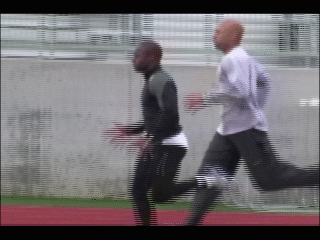
This muscle enables hip flexion, primarily internal, forward and outward rotation of the hip. It is also the dominant muscle that drives the knee forward when running and walking and, thus, is easily overused and vulnerable to shortening or tears. Tensor fasciae latae muscle syndrome is clinically expressed in pain in the area of the iliac crest, greater trochanter and the hip joint area. In many cases, this kind of myofascial pain can reflect to the lateral femoral condyle of the knee joint area. Pain increases with static load and active movement. These symptoms are very similar to those experienced in other disorders such as cases of hip disorders, lower back disorders, greater trochanter bursitis, etc. Therefore, at the time of performing a treatment for tensor fasciae latae muscle syndrome palpate to detect possible combinations of the above-mentioned disorders. (The sample of palpation technique is demonstrated at the beginning of every instructional video.)
The way it is usually done in the segment reflex massage, given that the innervation of the tensor fasciae latae muscles originates from the L4, L5, S1 spinal nerves, which actually converge into the superior gluteal nerve, the massage therapy procedure for the tensor fasciae latae muscle syndrome must start from superficial and deep fascia release on all areas of L-S sacroiliac, front and posterior-lateral thigh area.In order to understand the Tensor Fasciae Latae Muscle Syndrome massage protocol you should be familiar with the 12 petrissage techniques used in Medical Massage.
Tensor Fasciae Latae Muscle Syndrome ProtocolThe pictures offered below as steps illustration are the actual snapshots from the instructional medical massage educational video #9 |
Step 1 | |
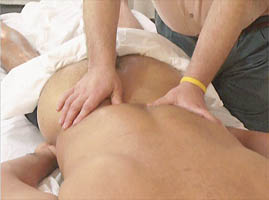 | With 2 thumbs bilateral, under pressure, massage the paravertebral zones from S1 to L1 area. Continue this procedure 5-6 times. |
Step 2 | |
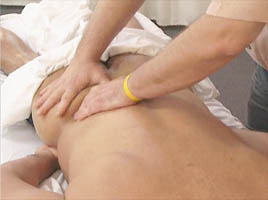 | Perform petrissage #1 followed by petrissage #2 on the lumbo-sacral area, including the glutes area, and piriformis area and region of the greater trochanter. |
Step 3 | |
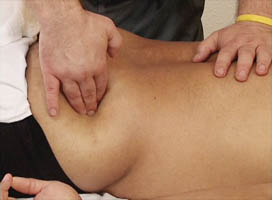 | Flex fingers of hand at 90 degree angle and under compression try to detect trigger points in the areas of the iliac crest, LS segments, glutes areas, sacroiliac joint region, and greater trochanter region. If trigger points are discovered apply ischemic compression on each discovered trigger point. |
Step 4 | |
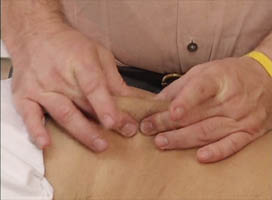 | Ask the client to lay on the unaffected side and place a pillow between his/her legs. Perform petrissage #1 and 2 in a short circular pattern in the areas of the iliac crest. |
Step 5 | |
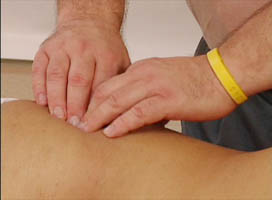 | Bend fingers at 90 degrees and use palpation to try to detect trigger points and tension areas in the iliotibial tract. |
Step 6 | |
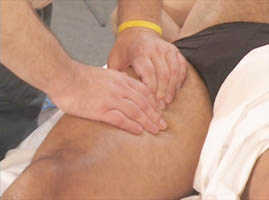 | Ask patient to lay face up. Perform massage therapy on the front thigh. It is best utilize techniques of effleurage, friction, petrissage #1, 2, 5, &/or 6. Cross fiber techniques are also highly recommended. |
Step 7 | |
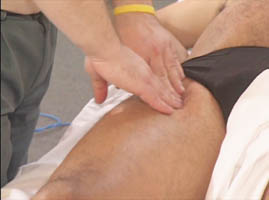 | Bend fingers at 90 degrees and palpate upper portion of thigh including the region of the iliac spine and iliopsoas muscles. As well as the lateral and posterior part of the upper thigh and hip area to the iliac crest (posterior-lateral and anterior parts should be tested). Upon discovering trigger points perform ischemic compression trigger point therapy. |





